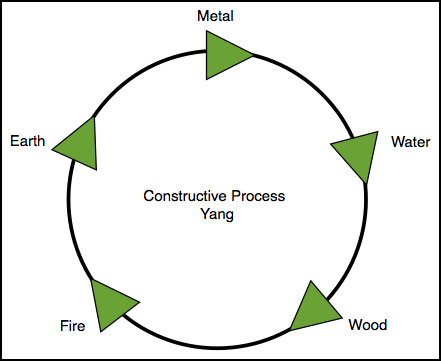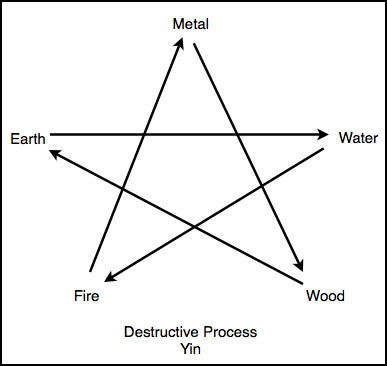The very first thing to keep in mind whilst looking at the 5 element processes is that they are symbolic. This is very important! The 5 processes are used in TCM and are of great importance to TCM practitioners. As qigong practitioners we don’t need to have a great in depth understanding, but it’s good to have an overview, which is the aim of this post.
Let’s start by taking a look at this diagram:

- Earth is where we find Metal
- Metal heated becomes liquid symbolised by Water
- Water helps to grow plants, which gives us Wood
- Wood is used as fuel to create Fire
- Fire creates burnt material which is nourishing to the soil, therefore Fire creates Earth
- Earth is where we find Metal
And on the creative cycle goes.
However take a look at this next diagram:

- Earth destroys Water by absorbing it
- Water destroys fire by extinguishing it
- Fire destroys Metal by melting it
- Metal destroys Wood by cutting it
- Wood destroys Earth by absorbing its nutrients
- Earth destroys Water by absorbing it
And the destructive cycle goes on and on.
It is important to note that both constructive and destructive cycles are required in order to create Yin/Yang harmony.
The ‘elements’ are linked to emotions and the 5 elemental processes are used to great effect with emotional disturbance:
- Metal corresponds to the Lungs which corresponds to Sorrow
- Water corresponds to the Kidneys which are linked to Fear
- Wood corresponds to the Liver and is linked to Anger/Aggression
- Fire corresponds to the Heart (physical, emotional and spiritual) and linked to Joy
- Earth corresponds to the Spleen and is linked with Anxiety
TCM practitioners and qigong healers can use the constructive and destructive processes for working with emotional and physical issues in a patient.
Remember this post was just to give you an overview, an introduction to the 5 elemental processes, whole books have been written on this subject alone, so to go into great detail is not possible here.
I’ve read a lot of books on TCM and you may call me bias, but the best one I have found that explains things clearly and consisely with lots of useful examples is Grandmaster Wong Kiew Kit’s – The Complete Book of Chinese Medicine.